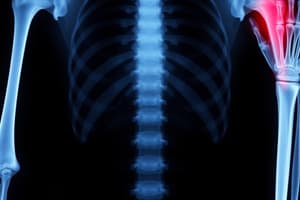Podcast
Questions and Answers
What should be removed from the patient before the procedure?
What should be removed from the patient before the procedure?
- Rings and watches (correct)
- Clothing
- Hair accessories
- Makeup
The patient should be positioned at the end of the table to avoid discomfort.
The patient should be positioned at the end of the table to avoid discomfort.
True (A)
What should be shielded during the procedure?
What should be shielded during the procedure?
gonads
What is the purpose of close collimation?
What is the purpose of close collimation?
When performing a bilateral examination of the hands or wrists, it is important to radiograph each side __________ to prevent distortion.
When performing a bilateral examination of the hands or wrists, it is important to radiograph each side __________ to prevent distortion.
What projection is recommended when joint injury is suspected?
What projection is recommended when joint injury is suspected?
In a PA projection for the second to fifth digits, how should the digits be positioned?
In a PA projection for the second to fifth digits, how should the digits be positioned?
In a lateral projection, the phalanges should show rotation.
In a lateral projection, the phalanges should show rotation.
In a PA oblique projection, the thumb should be __________ rotated.
In a PA oblique projection, the thumb should be __________ rotated.
What is one advantage of medially rotating the second digit in the STREET method?
What is one advantage of medially rotating the second digit in the STREET method?
What is the purpose of the LEWIS modification in the AP projection of the thumb?
What is the purpose of the LEWIS modification in the AP projection of the thumb?
Match the following projections with their details:
Match the following projections with their details:
Flashcards are hidden until you start studying
Study Notes
General Procedures for Upper Limb Positioning
- Remove all radiopaque objects (rings, watches) prior to procedure.
- Position patient at the side or end of the table to ensure comfort.
- Place the imaging receptor (IR) for optimal patient comfort and accessibility.
- Direct central ray perpendicular to the midpoint of the IR.
- Perform bilateral examinations of hands or wrists separately to reduce distortion of joint spaces.
- Use gonadal shielding to protect sensitive areas.
- Employ close collimation to limit radiation exposure.
- Include right or left markers for proper identification.
Positioning the Digits (Second to Fifth Digits)
PA Projection
- Patient Positioning: Palmar surface down, digits slightly separated.
- Central Ray: Perpendicular to PIP joint.
- Required Fields:
- Entire digit visible from fingertip to distal metacarpal.
- No soft tissue overlap between adjacent digits.
- No rotation evident; concavity of phalangeal bodies should be even on both sides.
- Open interphalangeal (IP) and metacarpophalangeal (MCP) joint spaces.
- Collimation: 1 inch (2.5 cm) on all sides, including proximal to the MCP joint.
Lateral Projection (Lateromedial or Mediolateral)
- Patient Positioning: Hand on lateral/radial surface (2nd and 3rd digits) or medial/ulnar surface (4th and 5th digits).
- Central Ray: Perpendicular to the PIP joint.
- Required Fields:
- True lateral position of digit without rotation.
- Concave anterior surfaces of phalanges visible.
- Open IP joint spaces.
PA Oblique Projection (Lateral Rotation)
- Patient Positioning: Hand pronated, rotated 45 degrees laterally (foam wedge may be used).
- Central Ray: Perpendicular to PIP joint.
- Required Fields:
- Entire digit rotated 45 degrees, concavity present on elevated side.
- No superimposition of structures.
- Open IP and MCP joint spaces.
Street Method (Medial Rotation)
- Technique: Medially rotate the second digit from a prone position to enhance visibility of fractures.
- Benefit: Improved recorded detail and reduced soft tissue interference.
Positioning the First Digit (Thumb)
AP Projection
- Patient Positioning: Arm internally rotated, thumb in medial rotation.
- Central Ray: Perpendicular to 1st MCP joint.
- Required Fields:
- Entire thumb with trapezium in profile.
- No rotation (concave surfaces of phalangeal and metacarpal bodies).
- Overlap of soft tissue profile.
- Open IP and MCP joint spaces.
Lewis Modification
- Adjusted Central Ray: 10-15 degrees toward the wrist along the long axis of the thumb.
- Rationale: To visualize the first metacarpal free from soft tissue overlap.
PA Projection for Thumb
- Patient Positioning: Thumb's dorsal surface parallel to the IR.
- Central Ray: Perpendicular to 1st MCP joint.
- Required Fields:
- Entire digit visible with trapezium in profile.
- No rotation evident.
- Overlap of soft tissue profile maintained.
Studying That Suits You
Use AI to generate personalized quizzes and flashcards to suit your learning preferences.




